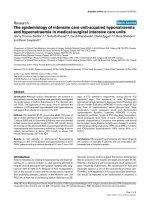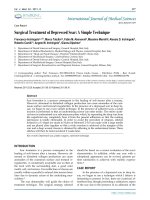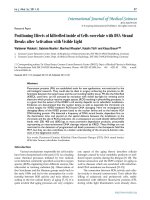Báo cáo y học: "ribriform-Morular Variant of Papillary Carcinoma: Association with Familial Adenomatous Polyposis Report of Three Cases and Review of Literature"
Bạn đang xem bản rút gọn của tài liệu. Xem và tải ngay bản đầy đủ của tài liệu tại đây (480.93 KB, 7 trang )
Int. J. Med. Sci. 2004 1(1): 43-49
43
International Journal of Medical Sciences
ISSN 1449-1907 www.medsci.org 2004 1(1):43-49
©2004 Ivyspring International Publisher. All rights reserved
Cribriform-Morular Variant of Papillary Carcinoma:
Association with Familial Adenomatous Polyposis -
Report of Three Cases and Review of Literature
Case report
Received: 2004.2.6
Accepted: 2004.3.17
Published:2004.3.20
Shylashree Chikkamuniyappa and Jaishree Jagirdar
Department of Pathology, University of Texas Health Science Center at San Antonio,
San Antonio, Texas 78229-3900, USA
A
A
b
b
s
s
t
t
r
r
a
a
c
c
t
t
We describe a rare variant of papillary thyroid carcinoma (PTC), the
Cribriform-Morular Variant (C-MV). A handful of cases have been
described in the literature of this entity. They exhibit the morphologic
features of a distinctive papillary neoplasm along with solid, cribriform,
and squamoid-morular areas. The cribriform and morular features make
this a separate entity which could be mistaken for a high grade aggressive
thyroid neoplasm. These lesions are usually associated with familial
adenomatosis polyposis (FAP) but rarely may be sporadic. We report
three cases that we have encountered.
K
K
e
e
y
y
w
w
o
o
r
r
d
d
s
s
thyroid neoplasm, papillary thyroid carcinoma, cribriform, squamoid,
morular
A
A
u
u
t
t
h
h
o
o
r
r
b
b
i
i
o
o
g
g
r
r
a
a
p
p
h
h
y
y
Shylashree Chikkamuniyappa, MD, is a final year Anatomic/Clinical pathology
resident at Univ TX Hlth Sci Ctr at San Antonio. She is serving as the Chief resident in
the department and serving on various institutional and national committees. She is
currently working on several research projects with faculty and presented at national
meetings. She will pursue her fellowship in hematopathology for the next 2 years.
Jaishree Jagirdar, MD, is the Professor and Director of Anatomic Pathology at the Uni
Tx Hlth Sci Ctr at San Antonio. After completing her residency in AP/CP at Mt. Sinai
Medical Center in New York, she stayed on as faculty for 10 years. Following that she
worked at New York University for another 11 years. Her area of expertise is in
Pulmonary Pathology, both diagnostic and research aspects. She is the Hlth Sci Ctr
Pulmonary Pathology Consultant and has published primarily on lung diseases for the
last 20 years.
C
C
o
o
r
r
r
r
e
e
s
s
p
p
o
o
n
n
d
d
i
i
n
n
g
g
a
a
d
d
d
d
r
r
e
e
s
s
s
s
Shylashree Chikkamuniyappa, MD, Department of Pathology, UTHSCSA Mail Code
7750, 7703 Floyd Curl Drive, San Antonio, Texas 78229-3900. Tel: (210) 567-6731 Fax:
(210) 692-1480 Email:
Int. J. Med. Sci. 2004 1(1): 43-49
44
1. Report of cases
Case 1.
Patient was a 32 year old G1P0 white female who presented with an enlarging painless lump in her
neck for the preceding two years. Ultrasound revealed a large, lobulated, right lobe mass. Serum level
showed: TSH-0.4 µ IU/ml, T3-1.88ng/ml (N: 0.6-1.81 ng/ml), free T4-1.2 ng/dl (N: 0.8-1.8 ng/dl) and
24 hour radio active iodine uptake-37%. She underwent a total thyroidectomy and is currently on
adjuvant radioactive iodine. She also underwent a proctocolectomy for multiple colonic polyps and
colonic carcinoma.
Case 2.
Patient was a 14 year old Latin American female with a gradually enlarging right neck mass for 2
years. CT scan showed several bilateral lesions. Fine needle aspiration showed normal follicular
cytology. Serum level showed: TSH-1.31 µ IU/ml, T4-0.92ng/ml (N: 0.6-1.81 ng/ml), free T4-2.6 ng/dl
(N: 0.8-1.8 ng/dl) and 24 hour radio active iodine uptake-28%. She underwent a total thyroidectomy
with subsequent radioactive ablation. There is no family history of colonic polyposis.
Case 3.
Patient was a 34 year old asymptomatic HIV positive female with bilateral neck masses. Fine
needle aspiration of the left lobe lesion showed papillary carcinoma. Serum level showed: TSH-1.92 µ
IU/ml, free T4-1.1 ng/dl (N: 0.8-1.8 ng/dl) and 24 hour radio active iodine uptake-31%. She underwent
a total thyroidectomy with subsequent radioactive ablation. She had a colectomy for multiple colonic
polyps.
Gross Pathology
Specimens revealed well-circumscribed, somewhat lobulated tan masses ranging from 1.5-2 cm
with multiple satellite nodules. There was no lobe predilection. There was no necrosis or hemorrhage
seen. The remainder of the thyroid was lobulated and beefy. Few lymph nodes were also identified.
Microscopic Pathology
The typical nuclear features of PTC could be seen. They were complex branching papillary
structures lined by cuboidal cells. The nuclei were hyperchromatic, optically clear with longitudinal
grooves and showed eosinophilic, intranuclear and cytoplasmic inclusions as in classic PTC (Fig 1).
Some lesions showed an intricate blending of several histological patterns (Fig 2). Cribriform areas had
back-to-back follicles with anastomozing bars and arches of cells in the absence of intervening
fibrovascular stroma and accounted for 30-50% of the lesions (Fig 3). The solid areas, which were
approximately 20-30%, consisted of whorls of cells that form squamoid morules or nests that typically
do not show any keratinization or intercellular bridges (Fig 4). No colloid or psamomma bodies were
found in the tumors. Case 3 also showed foci of tall and columnar cell features.
2. Comment
Cribriform-Morular Variant (C-MV) of PTC is a rare morphologic entity. It was first described
by Harach et al. [1]
in association with FAP as a distinctive tumor. A total of 44 cases have been
documented so far (See Table1). We describe three cases, in two of which the patients have FAP. Case
2 was lost to follow-up.
Two cases were women in their 30’s and the third was a 14 year old. The lesions ranged from 1.5
to 2 cm and were associated with several satellite nodules. There was no lymph node metastasis,
capsular or vascular invasion. Our cases are similar to that described by Cameselle-Teijeiro et al. [2]
who first proposed the term and did a study on nine cases. All the cases were seen in women between
ages of 16-30 years (mean: 21.3). The lesions were predominantly solitary and ranged from 1.5-5.6 cm.
All except one showed vascular invasion. Two cases also showed lymph node metastasis. In that study,
immunohistochemical stains were positive for thyroglobulin, epithelial membrane antigen, cytokeratin,
vimentin, estrogen and progesterone receptors, bcl-2 and Rb proteins. Calcitonin and carcinoembryonic
antigen were negative. Follow-up showed seven cases with no recurrences.
Int. J. Med. Sci. 2004 1(1): 43-49
45
C-MV of PTC is commonly seen in young females usually less than 30 years of age. The lesions
are encapsulated or well-circumscribed. While sporadic forms usually appear as an isolated tumors, the
cases associated with FAP are often multifocal due to different somatic mutations added to the germline
mutations [3]. They display the characteristic histologic pattern of cribriforming akin that seen in breast
cancer with morules. Morules appear squamous with no keratinization or cellular bridges. There are
also follicles showing papillary, trabecular and solid patterns.
There have been several cases showing germline mutations in the APC gene which have also been
found in the colonic polyps. Hot spots on codons 1061, 1039 and 698 of the APC gene on exon 15 are
frequently identified. It has been proposed that β-catenin immunohistochemistry is a feasible screening
method to identify occult FAP in young patients with thyroid tumors [4]. Recently Xu B [5] suggested
that accumulation of mutant β-catenin contributes to the development of C-MV of PTC. A handful of
sporadic cases have also been documented [6]. Table 1 summarizes all the cases in the literature.
Molecular studies were performed in all our cases and they did not show the hot spots of the APC gene.
C-MV carries a better prognosis than the other aggressive variants of PTC (tall cell, columnar,
diffuse sclerosing and diffuse follicular) and poorly differentiated carcinoma. Tall cell variant lacks
morular, cribriform and spindle cell areas. Columnar cell variant presents in older males. The
encapsulated form of columnar cell variant is common in females and histologically shows greater
overlap with C-MV but does not have the morules and cribriform pattern. Hyalinizing trabecular tumor
shows a zellballen pattern in a hyalinized amyloid-like background. Poorly differentiated (insular)
carcinoma shows areas mimicking cribriform structures but lacks morules and is associated with a
higher proliferation index and necrosis.
This morphologic variant should be borne in mind by pathologists because of its characteristic
pattern. The clinician should be alerted to exclude FAP along with appropriate family screening. In 25-
30% of cases, this might provide the first indicator of an underlying FAP syndrome.
Conflict of interest:
The authors have declared that no conflict of interest exists.
References
1. Harach HR., Williams GT., and Williams E.D. Familial adenomatous polyposis associated thyroid
carcinoma: a distinct type of follicular cell neoplasm. Histopathology, 1994. 6: 549-561.
2. Cameselle-Teijeiro J., and Chan J.K. Cribriform-morular variant of papillary carcinoma: a distinctive variant
representing the sporadic counterpart of familial adenomatous polyposis-associated thyroid carcinoma? Mod
Pathol, 1999. 4: 400-411.
3. Miyaki M., et al. Molecular evidence for multicentric development of thyroid carcinomas in patients with
familial adenomatous polyposis. Am J Pathol, 2000. 6: 1825-1827.
4. Kurihara K. Nuclear localization of immunoreactive b-catenin is specific to familial adenomatous polyposis
in papillary thyroid carcinoma. Jpn J Cancer Res, 2000. 91: 1100-1102.
5. Xu B, et al. Cribriform-morular variant of papillary thyroid carcinoma: a pathological and molecular genetic
study with evidence of frequent somatic mutations in exon 3 of the beta-catenin gene. J Pathol, 2003. 1: 58-
67.
6. Cameselle-Teijeiro J., et al. Somatic but not germline mutation of the APC gene in a case of cribriform-
morular variant of papillary thyroid carcinoma. Am J Clin Pathol, 2001. 115: 486-493.
7. Yamashita T., et al. Peculiar nuclear clearing composed of microfilaments in papillary carcinoma of the
thyroid. Cancer, 1992. 70(12): 2923-2928
8. Mizukami Y., et al. Encapsulated follicular thyroid carcinoma exhibiting glandular and spindle cell
components: A case report. Pathol Res Pract, 1996. 192(1): 72-74.
9. Hizawa K, et al. Association between thyroid cancer of cribriform variant and familial adenomatous
polyposis. J Clin Pathol, 1996. 49(7): 611-613.
10. Perrier N.D., et al. Thyroid cancer in patients with familial adenomatous polyposis. World J Surg, 1998.
22(7): 738-743.
11. Soravia C., et al. Familial adenomatous polyposis-associated thyroid cancer: a clinical, pathological, and
molecular genetics study. Am J Pathol, 1999. 154(1): 127-135.
12. Fenton P.A., et al. Cibriform variant papillary thyroid cancer: a characteristic of familial adenomatous
polyposis. Thyroid, 2001. 11(2): 193-97.
13. Cetta F., et al. Thyroid carcinoma associated with familial adenomatous polyposis. Histopathology, 1997.
31(3): 231-236.
Int. J. Med. Sci. 2004 1(1): 43-49
46
Tables and Figures
Table 1
Cases Sex/A
ge
(yr)
FA
P
Presentation Main Features APC
Mutation in
thyroid
Treatment Outcom
e
F/19 Yes Right neck mass 16 separate
nodules
ND Total thyroidectomy A&W at
25 yrs
F/34 Yes 2 cm ND
F/34 Yes 1 focus ND
Harach et
al. [1]
F/23 Yes 3 cm ND
F/30 No Right neck nodule
at 6 months
22 mm Absent Hemithroidectomy
(R),
Subtotal lobectomy
(L),
Radioactive iodine
A&W at
5 yr
F/16 No Left neck nodule
for 1 year
15 mm ND Total thyroidectomy,
Radioactive iodine
A&W at
14 yr
F/20 No Left thyroid nodule 12 mm (R), 23
mm (L)
ND Total thyroidectomy A&W at
4 yr
Cameselle-
Teijeiro
and Chan
[2]
F/19 No Right neck mass 19mm ND Total thyroidectomy Recent
case
F/21 No Anterior neck mass 40 mm ND Surgical resection A&W at
1-2 yr
F/23 No Anterior neck mass 50 mm, LN met
+
ND Surgical resection A&W at
1-2 yr
F/20 No Anterior neck mass 56 mm ND Surgical resection A&W at
1-2 yr
Yamashita
et al.[7]
F/21 No Anterior neck mass 26 mm ND Surgical resection A&W at
1-2 yr
Mizukami
et al.[8]
F/16 No Left neck nodule 20 mm Subtotal
thyroidectomy and
radical neck
dissection
A&W at
5 yr
Hizawa et
al.[9]
F/20 Yes Right neck mass 18 mm Exon 15 at
codon 1061
Hemithroidectomy
(R), and LN
dissection
A&W at
2 yr
Perrier et
al.[10]
11/12 cases
F/15-
61 yrs
Yes Bilateral : 5 18 mm (0.2-5
cm)
multicentric :8 2
cases with LN
met’s
All ND 5 Total
thyroidectomy
5 near total
thyroidectony
2 lobectomy
2 PO Iodine
10 T4 suppression
FU:&mo
s-30yr,
2
recurred
1 death
F/38 Yes Bilateral mass Multifocal (3-35
mm) capsular
and vascular +
Exon 15 at
codon 698
Total thyroidectomy Recurred
and died
F/24 Yes Bilateral mass 20-35 mm,
capsular
invasion
Exon 15 at
codon 698
Total thyroidectomy Recurred
Soravia et
al.[11]
F/51 Yes Bilateral mass 6-23 mm Exon 9 at
codon 312
Total thyroidectomy NP
Fenton et
al.[12]
F/20 Yes Diagnosis made
retrospectively
Diagnosis made
retrospectively
Exon 15 at
codon 1061
Total thyroidectomy
A&W at
14mos
Cameselle-
Teijeiro et
al. [6]
F/27 Yes Right neck mass x
14 mos
21 mm with
capsular
and
angioinvasion
Exon 15 at
codon 1309
somatic
mutation
Total thyroidectomy
A&W at
14mos
F/22 Yes NP Encapsulated Exon 15 at
codon 1061
NP NP Cetta et
al.[13]
F/20 Yes NP 8 mm Exon 15 at
codon 1309
NP NP
Int. J. Med. Sci. 2004 1(1): 43-49
47
F/36 Yes NP 11 mm Exon 15 at
codon 1309
NP NP
Present
Cases
F/32 Yes Anterior neck Multifocal In process Total thyroidectomy Recent
case
Fig 1









